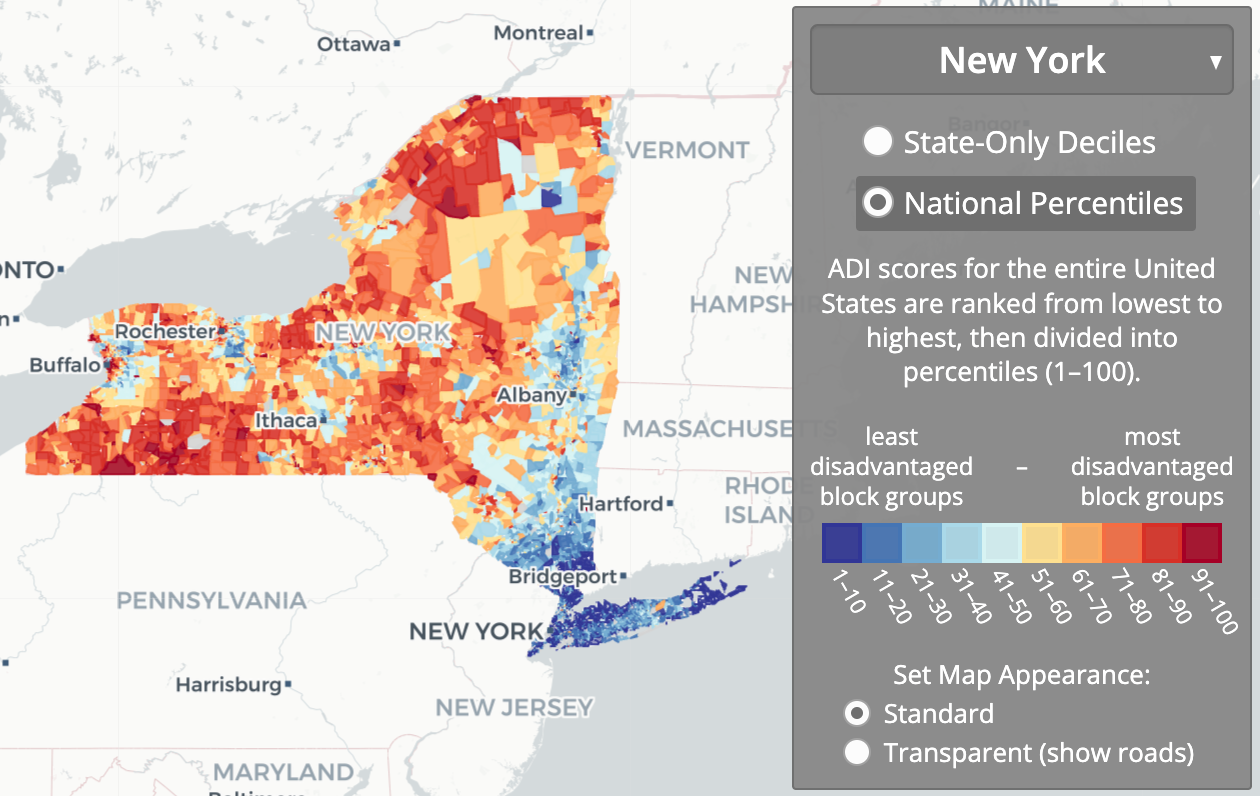Article
Area Deprivation Index informs policy but misses mark at provider level
Author(s):
Applied properly, ADI can be used to better understand markets and patient populations.
This sample New York Area Deprivation Index map was created through the website of the Applied Population Lab at the University of Wisconsin -Madison.

From New York’s Upper West Side to Los Angeles’ Compton, the reputation of some neighborhoods and the patients who live there precedes them. Family income, level of education, employment status and opportunities, and housing quality (or lack thereof) can all impact the socioeconomic ecosystem of neighborhoods. However, quantifying and even classifying the risk level of specific areas – think Compton, South Chicago, Franklin Park, and Detroit – can prove challenging. Enter the Area Deprivation Index (ADI), which ranks communities based on comprehensive, multidimensional assessments of each area’s socioeconomic conditions.
Appropriately ranking communities has substantial implications for the recommendations providers give patients from different communities since research documents the relevance of social determinants of health factors on health outcomes, such as correlations between more disadvantaged neighborhoods and higher rehospitalization rates.
Hillit Meidar-Alfi, PhD
Spatially Health

Currently, the Centers for Medicare and Medicaid Services (CMS) leverages the ADI to flag potential disparities in the health outcomes of different populations. Ultimately, incorporating ADI into patient health plans should correlate to improved health equity among patient populations, but it may differ in practice. CMS’s current use of the ADI highlights the agency's commitment to addressing health disparities and improving health outcomes for all Medicare beneficiaries, regardless of socioeconomic status, though work remains to make use of the ADI correlate with actual improved patient outcomes. Here’s how that looks in practice and what it means for physicians.
CMS utilizes ADI as a benchmark to assess risk levels of given areas. However, such use does not guarantee accountable care organizations’ (ACOs) success in improving actual health outcomes for patients in those regions. For instance, the ADI does not offer targeted intervention recommendations or suggestions for allocating resources to the most socioeconomically disadvantaged areas.
In addition to flagging potential high-risk regions, CMS uses ADI for quality measurement. For example, CMS can evaluate if risk-bearing organizations serve an appropriate number of high-risk areas based on the ADI.
Further, the ADI benefits CMS’s research endeavors that explore the relationship between socioeconomic disadvantages and health outcomes among Medicare beneficiaries. This research can inform policies and interventions aimed at addressing health disparities. In practice, ADI proves helpful at the policy level but does not necessarily translate to actionability at the provider level.
ADI has important implications for risk-bearing organizations and physicians alike. For ACO Realizing Equity, Access, and Community Health (REACH) and Medicare Shared Savings Program (MSSP) ACOs, ADI is used to calculate benchmark adjustments. And given that REACH ACOs have two adjustments to their benchmark – one for quality and another for health equity – ADI will impact revenue directly.
In particular, the ADI – in conjunction with the Census Block Group level – will create a composite measure to indicate high levels of deprivation or regions of prosperity. CMS will then use this information to determine the benchmark health equity adjustment rate for each ACO and their physicians based on how many beneficiaries are in top, mid, or bottom vulnerability areas.
Specifically, ADI can be used to better understand the markets and patient populations at the organization, provider, and patient levels.
- Organizations: One of the goals for CMS regarding health equity is to encourage ACOs to take on more vulnerable populations. Pairing ADI with a proper health barrier and intervention tool will allow risk-bearing organizations to better strategize how to provide for these more vulnerable communities.In addition, doing so offers a more significant opportunity to hit quality and benchmark metrics and improve their impact revenue.
- Providers: ADI gives providers a piece of the puzzle for understanding the risk level of their patients. However, the ADI alone cannot connect the dots in terms of what health barriers a given patient faces
- Patients: Trends demonstrate the higher the deprivation, the greater the average annual cost to support those patients. However, not all high ADI values indicate high health barriers, and not all lower scores mean lower health barriers.
And that’s the catch. Though helpful in calculating adjustments and consideration at the organization, provider, and patient levels, ADI does not give a complete picture of where, what, and who acts as barriers to health equity.
So what does this mean for risk-bearing organizations and their providers? ADI is a sophisticated index designed to identify disparities but does not tell providers how to help that patient.
That’s where proven tooling and platforms come in. Risk-bearing organizations and their physicians need a comprehensive data-driven platform to partner with them to drive their success.
Risk-bearing organizations have options in what tooling to leverage, but not all work equally well. The most effective options can identify health equity barriers at the patient level and deliver targeted intervention recommendations, the latter of which should boost patient engagement and advance medical management programs.
With the first quarter at a close, it’s time for risk-bearing organizations and physicians to evaluate if their tooling is working. If the group is not seeing improved return on investment and patient health outcomes – clear signs of a successful platform – then now is the time to consider adopting a platform that can deliver on both.
Hillit Meidar-Alfi, PhD, is the CEO and Founder of Spatially Health, a company that offers dynamic, customized SDoH analytics tech to ACOs. Complementing her expertise in spatial analytics, Dr. Meidar-Alfi has a background in city planning and architecture.





